Meriam Moujahid
FurNav: Development and Preliminary Study of a Robot Direction Giver
Sep 25, 2023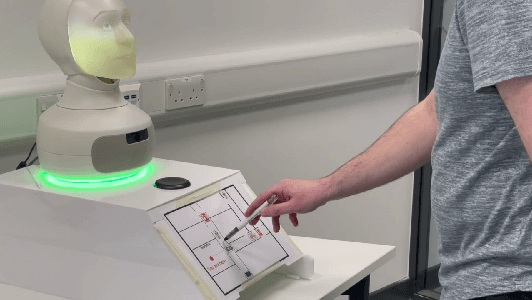

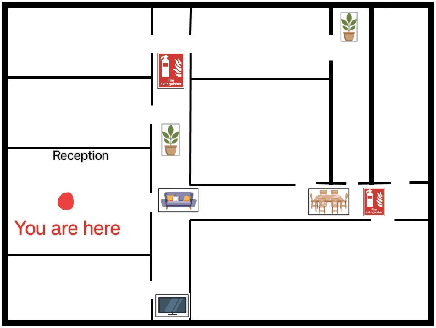

Abstract:When giving directions to a lost-looking tourist, would you first reference the street-names, cardinal directions, landmarks, or simply tell them to walk five hundred metres in one direction then turn left? Depending on the circumstances, one could reasonably make use of any of these direction giving styles. However, research on direction giving with a robot does not often look at how these different direction styles impact perceptions of the robots intelligence, nor does it take into account how users prior dispositions may impact ratings. In this work, we look at generating natural language for two navigation styles using a created system for a Furhat robot, before measuring perceived intelligence and animacy alongside users prior dispositions to robots in a small preliminary study (N=7). Our results confirm findings by previous work that prior negative attitudes towards robots correlates negatively with propensity to trust robots, and also suggests avenues for future research. For example, more data is needed to explore the link between perceived intelligence and direction style. We end by discussing our plan to run a larger scale experiment, and how to improve our existing study design.
Come Closer: The Effects of Robot Personality on Human Proxemics Behaviours
Sep 06, 2023



Abstract:Social Robots in human environments need to be able to reason about their physical surroundings while interacting with people. Furthermore, human proxemics behaviours around robots can indicate how people perceive the robots and can inform robot personality and interaction design. Here, we introduce Charlie, a situated robot receptionist that can interact with people using verbal and non-verbal communication in a dynamic environment, where users might enter or leave the scene at any time. The robot receptionist is stationary and cannot navigate. Therefore, people have full control over their personal space as they are the ones approaching the robot. We investigated the influence of different apparent robot personalities on the proxemics behaviours of the humans. The results indicate that different types of robot personalities, specifically introversion and extroversion, can influence human proxemics behaviours. Participants maintained shorter distances with the introvert robot receptionist, compared to the extrovert robot. Interestingly, we observed that human-robot proxemics were not the same as typical human-human interpersonal distances, as defined in the literature. We therefore propose new proxemics zones for human-robot interaction.
FurChat: An Embodied Conversational Agent using LLMs, Combining Open and Closed-Domain Dialogue with Facial Expressions
Aug 30, 2023Abstract:We demonstrate an embodied conversational agent that can function as a receptionist and generate a mixture of open and closed-domain dialogue along with facial expressions, by using a large language model (LLM) to develop an engaging conversation. We deployed the system onto a Furhat robot, which is highly expressive and capable of using both verbal and nonverbal cues during interaction. The system was designed specifically for the National Robotarium to interact with visitors through natural conversations, providing them with information about the facilities, research, news, upcoming events, etc. The system utilises the state-of-the-art GPT-3.5 model to generate such information along with domain-general conversations and facial expressions based on prompt engineering.
We are all Individuals: The Role of Robot Personality and Human Traits in Trustworthy Interaction
Jul 28, 2023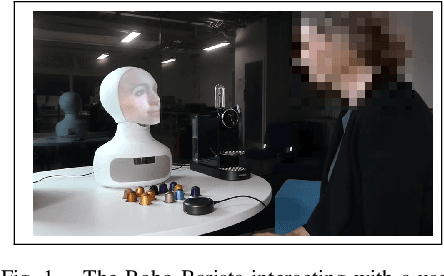
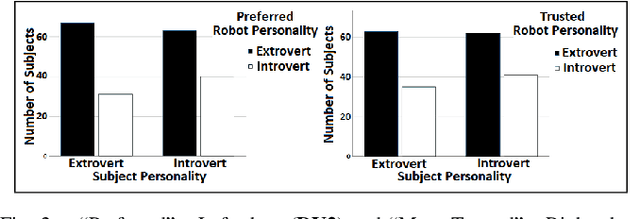
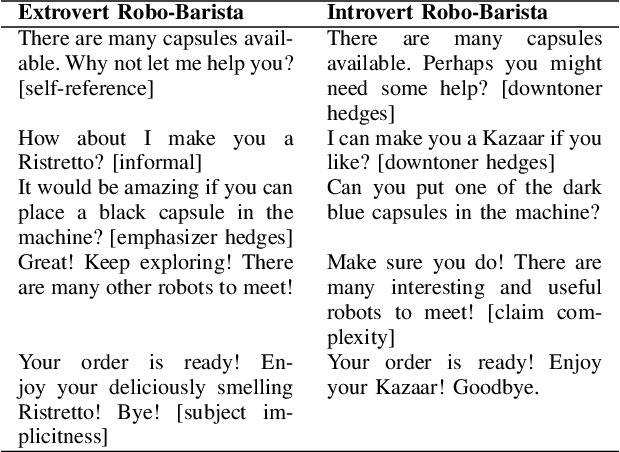
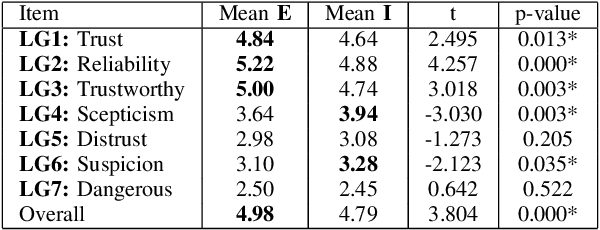
Abstract:As robots take on roles in our society, it is important that their appearance, behaviour and personality are appropriate for the job they are given and are perceived favourably by the people with whom they interact. Here, we provide an extensive quantitative and qualitative study exploring robot personality but, importantly, with respect to individual human traits. Firstly, we show that we can accurately portray personality in a social robot, in terms of extroversion-introversion using vocal cues and linguistic features. Secondly, through garnering preferences and trust ratings for these different robot personalities, we establish that, for a Robo-Barista, an extrovert robot is preferred and trusted more than an introvert robot, regardless of the subject's own personality. Thirdly, we find that individual attitudes and predispositions towards robots do impact trust in the Robo-Baristas, and are therefore important considerations in addition to robot personality, roles and interaction context when designing any human-robot interaction study.
* 8 pages, RO-MAN'22, 31st IEEE International Conference on Robot and Human Interactive Communication (RO-MAN), August 2022, Naples, Italy
 Add to Chrome
Add to Chrome Add to Firefox
Add to Firefox Add to Edge
Add to Edge